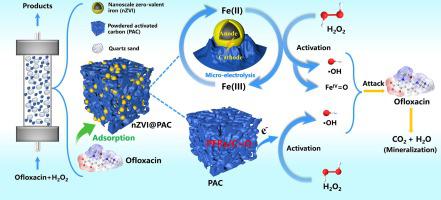当前位置:
X-MOL 学术
›
Chem. Eng. J.
›
论文详情
Our official English website, www.x-mol.net, welcomes your
feedback! (Note: you will need to create a separate account there.)
Ofloxacin degradation in water and porous media: Synergy effects via hydrogen peroxide activation by a micro electrolytic iron-carbon composite
Chemical Engineering Journal ( IF 13.3 ) Pub Date : 2023-12-21 , DOI: 10.1016/j.cej.2023.148090 Jinhu Yun , Yan Liang , Juntao Guo , Lu Jiang , Hongxiang Zhu , Hainong Song , Shuangfei Wang
Chemical Engineering Journal ( IF 13.3 ) Pub Date : 2023-12-21 , DOI: 10.1016/j.cej.2023.148090 Jinhu Yun , Yan Liang , Juntao Guo , Lu Jiang , Hongxiang Zhu , Hainong Song , Shuangfei Wang

|
Ofloxacin (OFL) may cause potential ecological risks since it cannot be effectively removed by conventional biological degradation. The advanced oxidation process is an efficient approach for antibiotic removal. Herein, a heterogeneous system for hydrogen peroxide (H2 O2 ) activation by nanoscale zero-valent iron (nZVI) supported on powdered activated carbon (PAC) composite (nZVI@PAC) was proposed to proceed with the removal of OFL. Typically, OFL (25 mg/L) can be removed up to 94.7 % within 60 min ([H2 O2 ] = 10 mM, [nZVI@PAC] = 125 mg/L, pH = 6, T = 318 K). The effects of initial OFL concentration, pH, nZVI@PAC dosage, H2 O2 concentration, and different actual water matrices were examined to explore the application conditions and resistance of the nZVI@PAC/H2 O2 system. Meanwhile, the quenching experiment, PMSO probe experiment, and EPR results showed •OH and FeIV 2 O2 to produce •OH and FeIV 2 O2 system and the toxicity assessment of intermediates were also given. Meanwhile, sequential runs and continuous flow column experiments showed nZVI@PAC/H2 O2 system had high stability. This work provides an innovative strategy of an advanced oxidation process based on heterogeneous reactions for organic contaminants removal using metal–carbon catalysts.
中文翻译:

氧氟沙星在水和多孔介质中的降解:微电解铁碳复合材料通过过氧化氢活化产生的协同效应
氧氟沙星(OFL)由于无法通过常规生物降解有效去除,可能会造成潜在的生态风险。高级氧化工艺是去除抗生素的有效方法。在此,提出了一种通过粉状活性炭(PAC)复合材料(nZVI@PAC)负载的纳米级零价铁(nZVI)活化过氧化氢(H2O2)的非均相系统,以去除OFL。通常,OFL (25 mg/L) 可在 60 分钟内去除高达 94.7%([H2O2] = 10 mM,[nZVI@PAC] = 125 mg/L,pH = 6,T = 318 K)。考察了OFL初始浓度、pH、nZVI@PAC用量、H2O2浓度和不同实际水基质的影响,以探讨nZVI@PAC/H2O2系统的应用条件和耐受性。同时,猝灭实验、PMSO探针实验和EPR结果表明·OH和FeIVO是体系中的主要反应物种。此外,提出了一种去除OFL的合理机制,即nZVI@PAC通过吸附在其表面聚集OFL,然后PAC上的持久性自由基(PFR)和nZVI通过激活H2O2产生·OH和FeIVO来降解OFL。此外,通过电化学实验和密度泛函理论(DFT)计算证明了微电子铁碳复合材料的效果。此外,还给出了OFL在nZVI@PAC/H2O2体系中的降解途径以及中间体的毒性评估。同时,顺序运行和连续流柱实验表明nZVI@PAC/H2O2体系具有较高的稳定性。这项工作提供了一种基于多相反应的高级氧化工艺的创新策略,用于使用金属碳催化剂去除有机污染物。
更新日期:2023-12-21
中文翻译:

氧氟沙星在水和多孔介质中的降解:微电解铁碳复合材料通过过氧化氢活化产生的协同效应
氧氟沙星(OFL)由于无法通过常规生物降解有效去除,可能会造成潜在的生态风险。高级氧化工艺是去除抗生素的有效方法。在此,提出了一种通过粉状活性炭(PAC)复合材料(nZVI@PAC)负载的纳米级零价铁(nZVI)活化过氧化氢(H2O2)的非均相系统,以去除OFL。通常,OFL (25 mg/L) 可在 60 分钟内去除高达 94.7%([H2O2] = 10 mM,[nZVI@PAC] = 125 mg/L,pH = 6,T = 318 K)。考察了OFL初始浓度、pH、nZVI@PAC用量、H2O2浓度和不同实际水基质的影响,以探讨nZVI@PAC/H2O2系统的应用条件和耐受性。同时,猝灭实验、PMSO探针实验和EPR结果表明·OH和FeIVO是体系中的主要反应物种。此外,提出了一种去除OFL的合理机制,即nZVI@PAC通过吸附在其表面聚集OFL,然后PAC上的持久性自由基(PFR)和nZVI通过激活H2O2产生·OH和FeIVO来降解OFL。此外,通过电化学实验和密度泛函理论(DFT)计算证明了微电子铁碳复合材料的效果。此外,还给出了OFL在nZVI@PAC/H2O2体系中的降解途径以及中间体的毒性评估。同时,顺序运行和连续流柱实验表明nZVI@PAC/H2O2体系具有较高的稳定性。这项工作提供了一种基于多相反应的高级氧化工艺的创新策略,用于使用金属碳催化剂去除有机污染物。































 京公网安备 11010802027423号
京公网安备 11010802027423号